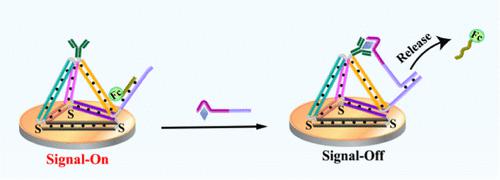当前位置:
X-MOL 学术
›
Anal. Chem.
›
论文详情
Our official English website, www.x-mol.net, welcomes your
feedback! (Note: you will need to create a separate account there.)
Antibody-Protein-Aptamer Electrochemical Biosensor based on Highly Efficient Proximity-Induced DNA Hybridization on Tetrahedral DNA Nanostructure for Sensitive Detection of Insulin-like Growth Factor-1
Analytical Chemistry ( IF 6.7 ) Pub Date : 2024-02-21 , DOI: 10.1021/acs.analchem.3c05035 Lin-Lin Long 1 , Wen-Xi Hu 1 , Xin Wang 1 , Ruo Yuan 1 , Ya-Qin Chai 1
Analytical Chemistry ( IF 6.7 ) Pub Date : 2024-02-21 , DOI: 10.1021/acs.analchem.3c05035 Lin-Lin Long 1 , Wen-Xi Hu 1 , Xin Wang 1 , Ruo Yuan 1 , Ya-Qin Chai 1
Affiliation

|
Herein, an antibody-protein-aptamer electrochemical biosensor was designed by highly efficient proximity-induced DNA hybridization on a tetrahedral DNA nanostructure (TDN) for ultrasensitive detection of human insulin-like growth factor-1 (IGF-1). Impressively, the IGF-1 antibody immobilized on the top vertex of the TDN could effectively capture the target protein with less steric effect, and the ferrocene-labeled signal probe (SP) bound on the bottom vertex of the TDN was close to the electrode surface for generating a strong initial signal. In the presence of target protein IGF-1 and an aptamer strand, an antibody-protein-aptamer sandwich could be formed on the top vertex of TDN, which would trigger proximity-induced DNA hybridization to release the SP on the bottom vertex of TDN; therefore, the signal response would decrease dramatically, enhancing the sensitivity of the biosensor. As a result, the linear range of the proposed biosensor for target IGF-1 was 1 fM to 1 nM with the limit of detection down to 0.47 fM, which was much lower than that of the traditional TDN designs on electrochemical biosensors. Surprisingly, the use of this approach offered an innovative approach for the sensitive detection of biomarkers and illness diagnosis.
中文翻译:

基于四面体 DNA 纳米结构高效邻近诱导 DNA 杂交的抗体-蛋白质-适体电化学生物传感器用于灵敏检测胰岛素样生长因子-1
在此,通过四面体 DNA 纳米结构 (TDN) 上的高效邻近诱导 DNA 杂交设计了一种抗体-蛋白质-适体电化学生物传感器,用于超灵敏检测人胰岛素样生长因子-1 (IGF-1)。令人印象深刻的是,固定在TDN顶部顶点的IGF-1抗体可以有效捕获目标蛋白,空间效应较小,并且结合在TDN底部顶点的二茂铁标记信号探针(SP)靠近电极表面用于产生强烈的初始信号。在目标蛋白IGF-1和适体链存在的情况下,可以在TDN的顶部顶点形成抗体-蛋白质-适体三明治,这将触发邻近诱导的DNA杂交,从而释放TDN底部顶点的SP;因此,信号响应将急剧下降,从而提高生物传感器的灵敏度。因此,所提出的目标 IGF-1 生物传感器的线性范围为 1 fM 至 1 nM,检测限低至 0.47 fM,远低于电化学生物传感器的传统 TDN 设计。令人惊讶的是,这种方法的使用为生物标志物的灵敏检测和疾病诊断提供了一种创新方法。
更新日期:2024-02-21
中文翻译:

基于四面体 DNA 纳米结构高效邻近诱导 DNA 杂交的抗体-蛋白质-适体电化学生物传感器用于灵敏检测胰岛素样生长因子-1
在此,通过四面体 DNA 纳米结构 (TDN) 上的高效邻近诱导 DNA 杂交设计了一种抗体-蛋白质-适体电化学生物传感器,用于超灵敏检测人胰岛素样生长因子-1 (IGF-1)。令人印象深刻的是,固定在TDN顶部顶点的IGF-1抗体可以有效捕获目标蛋白,空间效应较小,并且结合在TDN底部顶点的二茂铁标记信号探针(SP)靠近电极表面用于产生强烈的初始信号。在目标蛋白IGF-1和适体链存在的情况下,可以在TDN的顶部顶点形成抗体-蛋白质-适体三明治,这将触发邻近诱导的DNA杂交,从而释放TDN底部顶点的SP;因此,信号响应将急剧下降,从而提高生物传感器的灵敏度。因此,所提出的目标 IGF-1 生物传感器的线性范围为 1 fM 至 1 nM,检测限低至 0.47 fM,远低于电化学生物传感器的传统 TDN 设计。令人惊讶的是,这种方法的使用为生物标志物的灵敏检测和疾病诊断提供了一种创新方法。











































 京公网安备 11010802027423号
京公网安备 11010802027423号